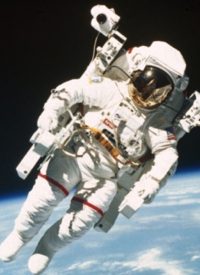
As NASA’s manned space efforts falter in the face of the looming conclusion of the shuttle program and by a finding of the Augustine Committee that projects that government-funded space exploration will be significantly more expensive in coming years, private space ventures are soaring.
Virgin Galactic — in which Richard Branson’s Virgin group is majority share holder — plans to begin offering sub-orbital space flights for would-be astronauts who can afford the $200,000 ticket as early as 2011.
An important benchmark on the way to beginning such commercial flights was the rollout of SpaceShipTwo on December 7. According to Wired.com:
SpaceShipTwo was built by Scaled Composites under the guidance of legendary aircraft designer Burt Rutan. The carbon composite spacecraft uses the same fuselage as its mother ship, VMS Eve. After a year of rigorous testing, VMS Eve completed flight testing earlier this fall. Rutan didn’t specify when flight testing for SpaceShipTwo would begin, though it is expected to start early next year.
Sub-orbital passenger flights could start as early as 2011 from Virgin Galactic’s space port in New Mexico which is currently under construction. Tickets for the early adopters are $200,000 for a training program culminating with the ride into space. Both Rutan and Virgin Galactic founder, Sir Richard Branson have repeatedly said they expect the prices to drop rapidly similar to many new technologies, including the early days of air travel.
Three hundred individuals have already paid a deposit to be in line for the initial flights; with prospects for a decrease in fares in the coming years, the number of‘space-tourist astronauts may rapidly grow far beyond the number of astronauts and cosmonauts whose space flights were paid for with government funds.
An article at Popsci.com places the significance of efforts by Virgin Galactic (and other private space companies such as SpaceX) in perspective:
For now, space tourists (a term the industry intensely dislikes, preferring to call them “spaceflight participants” or “space explorers”) are the cornerstone of Virgin’s business model, but with NASA struggling to fund its lofty dreams of missions to the moon and beyond, and with the shuttle headed for retirement, Virgin and dozens of other private space entrepreneurs see a golden opportunity to do something much more fundamental — and more profitable. Beyond carrying wealthy passengers into suborbital space, Whitehorn says, Virgin could also launch rockets and satellites, provide affordable transport for scientists who want to do microgravity experiments in space, and even establish a private astronaut-training program. Seen in that light, space tourists become much more than just the idle rich undertaking a mind-blowing experience for the thrill of it. Indeed, the space industry says that demand from tourists — and companies that need satellites — will provide the seed capital for what is, in effect, the privatization of space.
As I walked around the ship, I got to thinking: 100 years ago, after the critics were forced to accept that yes, man can fly, many dismissed flight as a diversion for the wealthy few. “The public has greatly over-estimated the possibilities of the aeroplane, imagining that in another generation they will be able to fly over to London in a day,” wrote a Harvard University astronomy professor, William Pickering, in 1908. “This is manifestly impossible.”



